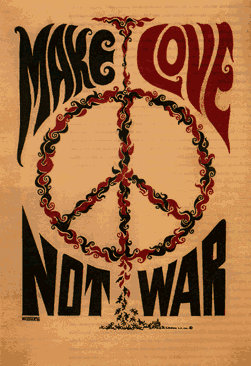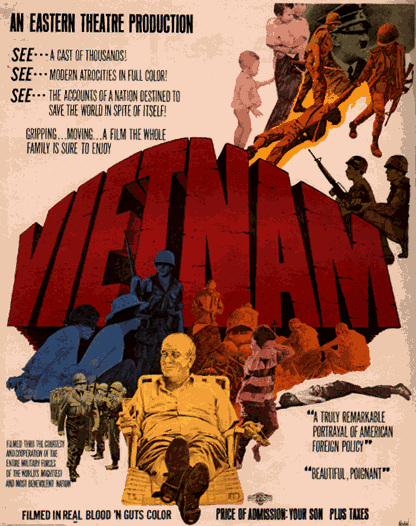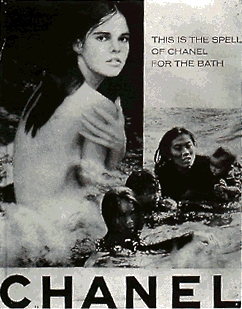|
Chapter summaries
|
Online Chapter: Peace Symbols: Posters in Movements against the Wars in Vietnam and IraqTwo posters, forty years apart, with the same words but different images and very different contexts:
Figure 1. Weisser, 1967. Courtesy of Sixties Project. [D of P, 34] Do they suggest that peace is just a recurring dream, a fantasy? Do they tell us that our political leaders cannot learn from history? Or do they tell us something else entirely? This chapter will sort through these and other questions as it examines some of the similarities and differences between the Vietnam era peace movement (1965–75), and the ongoing movement against the invasion and occupation of Iraq (2003–). As Figure 3 suggests, many in the current Iraq peace movement have already drawn parallels with the war in Vietnam. But historical parallels are always tricky. Seeking to show repeated patterns can make you miss those things that are different and thus require new approaches. In looking at these two movements, I’ll show their similarities while pointing out how they differ in ways that may matter to current and future organizing for peace.
Figure 3. No author, 2003. Courtesy of Peace Symbol.org. The movement culture form I will use to compare and contrast the peace actions in the protest poster. This is a particularly appropriate choice since the modern protest poster developed in response to war and in the form of the military recruitment poster. Beginning during World War I (or the Great War, as it was known then, since it was advertised as the “war to end all wars”), the recruitment poster became a major part of nation-state propaganda throughout the United States, Europe, and elsewhere. The most famous such poster in the United States is no doubt the “Uncle Sam Wants You” poster designed in 1917 by James Montgomery Flagg (Figure 4). This image has been and continues to be parodied frequently in peace movement posters (Figures 5 and 6), keeping alive the form’s origins in counter-recruitment efforts.
Figure 4. James Montgomery Flagg, 1917. Public domain. Extending the logic of recycling and improving the Uncle Sam poster, solider turned artist Micah Wright has created a whole series of “remixed” propaganda posters.1 He updates a World War II poster (Figure 7, left) that helped fuel the anti-Japanese paranoia that led to an executive order that imprisoned more than one hundred thousand citizens of Japanese ancestry. The remix (Figure 7, right) is directed at the prime architect of recent legislation, the so-called PATRIOT Act, which has had a similar impact on the lives of thousands of Arabs, Muslims, Middle Easterners, and thought-to-be Middle Easterners in the United States.
Figure 7. Micah Wright. Courtesy of the Propaganda Remix Project. Posters have changed in style, mode of production, and method of distribution over the years, from laboriously handmade silk-screened images stapled to trees to images made and circulated instantaneously across the world by computer. But their basic functions have remained the same. Movement posters are designed, as are the military ones they counter, primarily as recruitment and educational devices. They aim to tell a story quickly, dramatically, and primarily visually. They must condense often quite complex ideas and ideological positions into a few images and words. As with murals (see chapter 43), poster imagery can even speak to audiences of limited literacy. In addition to serving to recruiting new members, posters can remind current members of key events and reinforce key ideas. And they can educate people to about crucial issues, intriguing drawing them in with a few words or images that draw you in because they want to know more. The visual language of the contemporary protest poster originates in a number of sources. In addition to parodying the military poster, movement posters often use techniques from the art world. Sometimes this is simply the use of certain colors, tones, or styles. The “Make Love, Not War” poster from 1967 (Figure 1) derives from the “psychedelic” style of the sixties rock concert poster, while the updated one from the Iraq antiwar effort (Figure 2) borrows the forms of “graffiti” artist and activist Keith Haring. At other times influence from the art world may take the form of recontextualizing a famous artwork. For example, there are many variations of Picasso’s protest painting Guerníca, as in the posters below (Figures 8 and 9). The poster in Figure 8, “Iraqnica,” seeks to link the fascist bombing of the Spanish town for which Picasso’s painting is named to the commercial interests protesters claim lie behind the bombing of Iraq. The poster may also serve as a reminder that art itself has become a commodity, with works like those of the great anticapitalist Spanish master now hanging now on the walls of the very corporations he detested and that peace activists hold responsible for the war system. “Iraqnica” (Figure 9) is more direct in paralleling Guernica and Iraqnica, evoking for those who know history that in both cases it was civilians, not soldiers, who bore the brunt of the falling bombs.
Figure 8. Nowar, circa 2003. Courtesy of Miniature Gigantic. Another favorite source for poster inspiration is American popular culture. In both the Vietnam and the Iraq war eras, movie posters proved useful in suggesting the unreality of war to those in power and the way in which wars are produced and consumed like films (Figures 10 and 11).
Figure 10. “Vietnam: An Eastern Theatre Production.” Courtesy of Sixties Project. Parodies of advertising were also popular in both eras, linking the selling of war to the selling of popular products, and the passive consumption of war images with quiescent consumption of consumer goods (Figures 12 and 13). One of the most famous antiwar poster groups of the sixties, the Committee to Help Unsell the War, consisted of professional ad agency artists and writers who committed themselves to using their skills to “unsell” the war rather than to sell products. In another sign of continuity across eras, the group was revived in 2003, and continues to work to “unsell” the war in Iraq. Figure 12. “Chanel,” Violet Ray, 1969. Courtesy of Sixties Project. While these and other parallels exist in the form and to some degree in the content of antiwar posters, there are significant differences in the two eras. Most important is the ability of contemporary poster-style images to be spread much more rapidly and fully via the World Wide Web. As we will see in our discussion of the movement against the war and occupation of Iraq, the Web has allowed peace movements to compete much more fully with mainstream mass media as modes of widespread dissemination of images. The Web has become both a “virtual wall” on which posters are posted and a means of disseminating images that can be downloaded and posted the old-fashioned way on trees, walls, fences, billboards, or any other public space. 1 Wright has created a vast collection of what he calls “remixed” posters, based on World War I and World War II propaganda posters but improved. He has gathered these images in book form as You Back the Attack! We’ll Bomb Who We Want (New York: Seven Stories Press, 2003). << >> |
|||














